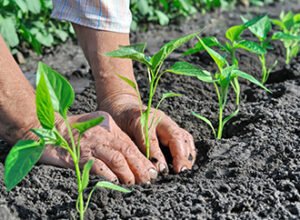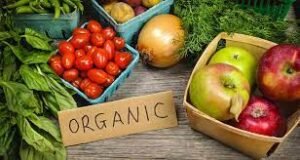Organic farming of vegetables
Continuously cultivating in the same field by chemical method causes abnormally nutrient deficiency in the soil. Due to which the soil loses its fertility. To fulfill which more chemical fertilizers are required. By doing continuous and unbalanced and inadequate nutritional management in which nutrients are generally lacking from organic sources.
It is mainly responsible for the decline in the fertility and productivity of the land. The use of chemical fertilizers is incapable of maintaining the fertility and crop productivity of the land for a long time.
When you talk about organic farming, this farming technique helps in maintaining the fertility and crop productivity of the soil for a long time, as well as in maintaining the physical, chemical and biological properties of the soil.

There are more soil nutrients through biological means, there are secondary and micronutrients, and there is no shortage of them. Considering the increasing price of fertilizers at the national level and the widening gap between demand and supply, more importance should be given to organic farming techniques. Organic farming techniques include organic manure, pulses, green manure, crop residues, bacterial manure, earthworm manure, biological control of pests and diseases, water management livestock management and people’s participation.
How to do Intercropping In Organic Farming?
How to do Organic Nutrition Management
Use of organic fertilizers for adequate availability of organic matter in the soil, the use of organic manures is essential. Organic fertilizers have beneficial effects on the physical structure and chemical and biological properties of the soil.
By the use of one ton of cow dung and village compost 5-8 kg Nitrogen, 30-35 kg Phosphorus and 5-6 kg. Get potash. Urban compost has a slightly higher average nutrient content. 30-70 kg of Nitrogen 8-20 kg with the use of one ton karanj, neem castor, groundnut, coconut, Sarguja, sesame etc. cake cake. Phosphorus and 10-20 kg potash are available.
Use of pulse crops – Pulses can be combined with vegetable farming. Mainly pulse crops can be grown as an end crop along with vegetables or as green manure. The inclusion of pulse crops leads to an encouraging increase in the yield of vegetables and stability in the yield. Growing pulse crops in the field gives the benefit of atmospheric nitrogen fixation done by them. 40-90 kg from pulse crops like cowpea, pea soybean, groundnut, bean etc.
Use of Green Manure – The use of green manure increases the amount of nitrogen in the soil in addition to organic matter. In addition, biochemical reactions are accelerated and the conservation and availability of nutrients increases. Dhaicha and Sanai in the green manure grown in the rainy season and Senji (Melilotus alva) and Berseem (Trifolium alexandrinum) are prominent among the green manures grown in the dry season.
How to do Pest & disease management in Organic Vegetables Farming?
Plowing of green manure should be done at the time when the crop has enough leaves but they are not hard so that they rot easily after transplanting. Usually by sowing after 45-50 days, plowing should be done by turning green manure. Apart from this, the leaves can be used as green manure. One ton of Gliricidia green leaves contain 30-40 kg nitrogen, 30-32 kg phosphorus and 30-32 kg phosphorus. 15-25 kg of potash is obtained, 30-35 kg of nitrogen, 25-28 kg of phosphorus and 14-15 kg of potash are obtained by using one ton of subabul leaves.
The use of crop residue of paddy, groundnut husk, stems of sorghum and mahua etc. Increases the organic carbon in the soil as well as the physical structure of the soil becomes excellent. Soil will get 3-15 kg of nitrogen in one ton of crop residue 2-7 kg Phosphorus and 3-20 kg of potash.
Use of bacterial fertilizers – Some bacteria fix atmospheric nitrogen by living in or around the roots of the plant or make the available insoluble phosphorus in the soil useful for the plants, thus making an active contribution in increasing the growth and yield of plants as well as It also maintains the fertility of the land. These are given in the form of bacterial fertilizers to the crops.

Nitrogen providing bacteria – The bacteria present in the fertilizers convert the nitrogen gas available in the environment into ammonia and make it easily available to the plants. In order to increase the availability of nitrogen in pulses ethnic vegetables like cowpea, pea, and bean etc Rhizobium bacterium should be used. The bacterial fertilizers that increase the availability of nitrogen in other vegetable crops are Azotobacter and Azospirillium.
How to do crop planning in Organic Farming?
Bacterial fertilizers – That provide phosphorus contain such bacteria. Those which convert the insoluble phosphorus present in the soil into a soluble form. So that plants can easily use it as their food. Bacterial fertilizers that make insoluble phosphorus soluble are available in the market under the names Phosphobactin and Phosphatica.
Methods of using different bacterial feeds
Seed treatment with bacterial fertilizers – In these method 250 grams of after boiling jaggery in one liter of water, after cooling, mix 500 or so of bacterial fertilizers and enough seed for one hectare, after drying it in a shady place for half an hour, this treated seed should be sown.
It is necessary to protect the bacterial culture from sunlight. For tuber treatment, 2 kg culture should be mixed thoroughly in 5 liters of water, enough tubers for one hectare should be treated in it and after drying in a shady place for half an hour, sowing should be done.
For soil treatment, 2 kg of culture, 25 kg of cow dung mixed with rotted manure and 25 kg of soil, cover it with soaked jute sacks, cover it with shady and turn twice at an interval of 5 days, after 15 days, apply the mixture to one hectare. The process is called charging. Fertilizers and chemical drugs should not be used at the time of use of bacterial fertilizers.
Use of Earthworm Manure (Vermi Compost) – This is a high quality balanced organic fertilizer prepared by earthworms named Asenia fotida and Police eugenics. In addition to nitrogen (08-12 percent), phosphorus (07-12 percent) and potash (10-15 percent), micronutrients and enzymes are available. Which are essential for plants? It also increases the fertility of the soil and the water holding capacity of the soil.
Best Method to convert your farm into Organic Farm.
Before sowing / transplanting, earthworm manure should be mixed in the soil at the rate of 20-30 vittals per hectare. After the use of earthworm manure, its effect is good by giving banks (mulching) by laying straw, dry leaves or garbage on the surface of the land. Fertilizers and chemical drugs should not be used while using it.
How to control pests and diseases?
Management of pests and diseases by chemical drugs is a simple and effective method. But along with the management of excessive use of chemical drugs, many new problems for the agricultural system such as the creation of insecticide resistance in the insect, pollution of the environment and ground water, the amount of chemical drug residue in agricultural products has adverse effects on human health of the crop. The decline in the number of natural enemies of insects, the decline in the storage capacity of crops is prominent.

The following measures can be adopted to control pests and diseases.
- Solarization of soil for self plant production and prevention of viral diseases by use of nylon mesh.
- Using karanj and neem cake in the field catching insects by pheromone trap. Insects and diseases caused by natural enemy’s prevention.
- To reduce the problem of diseases and insects by using solution of leaves of botanical substances like neem, tulsi, lentana, karanj etc.
- Use of trap crops such as mustard (for control of rhizomes of cabbage or diamondback moths) and genda (Marigold)(for control of tomato fruit borer weeds) etc. By all these measures, proper protection of the crop can be done at low cost.
Major biological pests and diseases
Trichoderma It is a biological fungicide based primarily on Trichoderma viridae. It has been found effective in diseases like potato, turmeric, ginger, onion, garlic, root rot, stem rot, scorching etc., which are caused by fungus. Along with this, it has also been found suitable for bacterial wilt disease of tomato and brinjal.
How to prepare best kitchen Garden?
Many soil borne diseases can be prevented by its use, as well as the growth of plants is good. For treatment, before planting nursery in vegetables, 2-4 g. Plant the seeds by treating Trichoderma at the rate of per kg seed. To use Trichoderma in the field, apply dung manure after treatment. Sprinkle Trichoderma powder in a bullock cart decomposed cow dung (250-300 kg) and mix it well.
Flip it twice at an interval of five days so that the Trichoderma gets mixed well in the compost and the mold spreads throughout the compost. To maintain the moisture in the compost, it should be covered with polythene in the winter with a bank of jute sacks or newspaper during the summer. It may be noted that light moisture (20 percent) should be maintained in it and the temperature should not rise above 50 ° C. This done is called charging. Manure prepared in this way should be given to vegetables and fruits.
Trichogramma It is based on small wasps which are parasites of the eggs of moths. Its 8 to 12 cards per hectare are applied 3-4 times in the evening at an interval of 10 to 15 days. Trichogramma bacteri is used for cauliflower and cabbage and Trichogramma colonis is used in other vegetables.
Biological nematode – It is made from a fungus called Pacilomyces lilacinus, which controls the worms by staying in the ground and sometimes by eating female nematodes. In vegetable crops, at the time of sowing or immediately after it, 50 kg should be applied. If there is no moisture in the field, then water should be arranged at the earliest. For nursery use 20 g of organic nematode in 1 sqm.
Verticillium leucani – This is also an organic insecticide based on the fungus, which is the whitefly, mahu controls by spreading disease on thrips etc. For this 2 kg. Dissolve Yorticillium leucani in 500 liters of water and spray it on the standing crop.

N.P.V is a virus derived from the body of the green caterpillar that protects tomatoes from fruit borers. For its use 250 L. E. (Larva Equivalent) 250 g jaggery and 250 ml in 500 liters of water per hectare mix with detergent and use.
Neem based insecticide is used for white fly, beetle,
How to use Mulch in Your Farm?
Phdka (jascids), scabbard insect, twig and fruit borer is done on the larva. It weakens the life cycle of insects. To make neem seed solution, grind 35 kg neem seeds in water and take 100 liters. Prepare the solution and store it in the tub. After 12 hours, filter it with a cloth and add 6 liters of solution per liter. Mix it with water and sprinkle. About 700 liters for spraying on a vegetable crop planted in one hectare. Neem seed solution is required.
Apart from the above techniques, export market will be easily available to ordinary farmers by adopting water management and livestock management and forming self-help groups at low cost.




